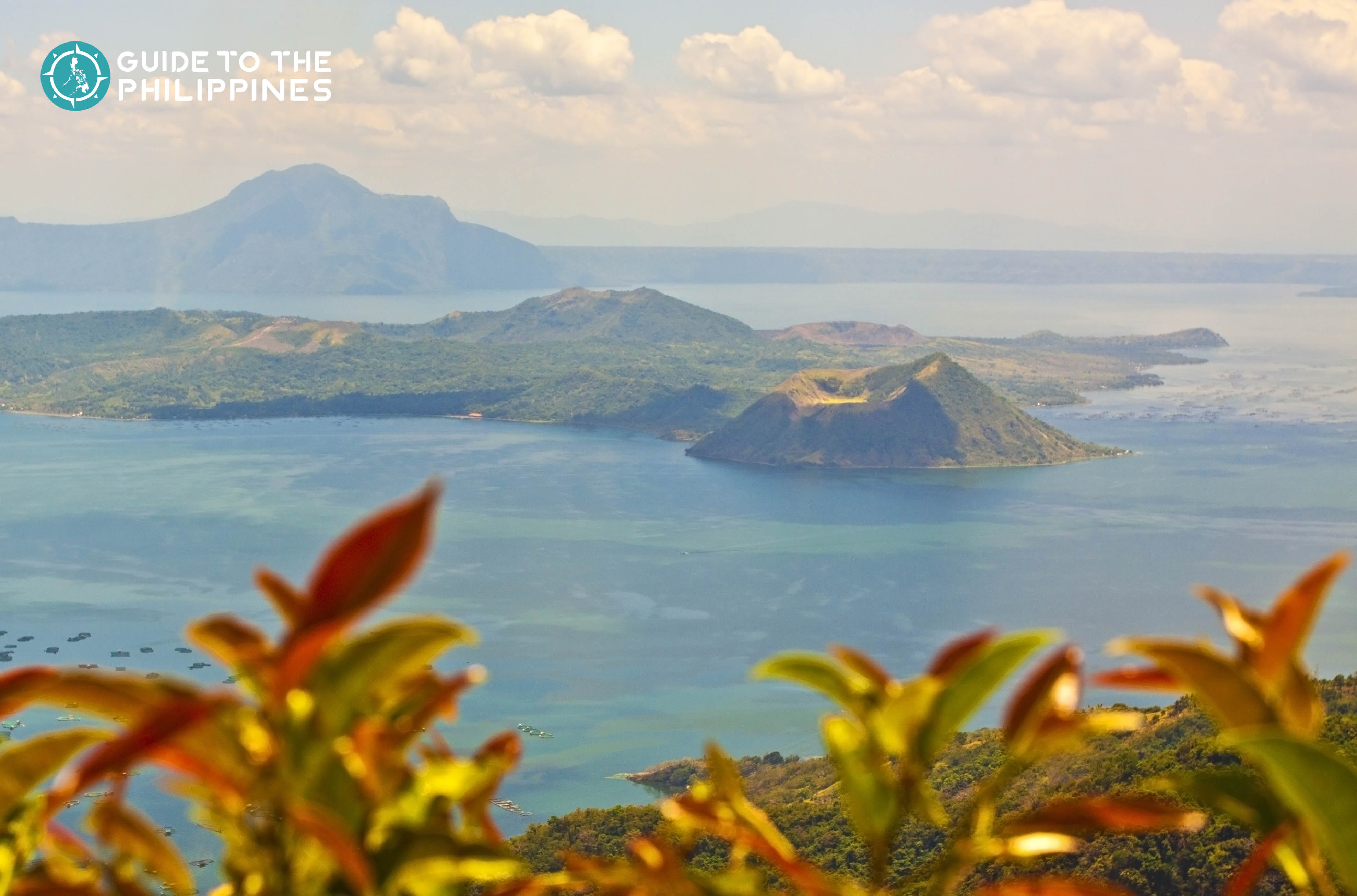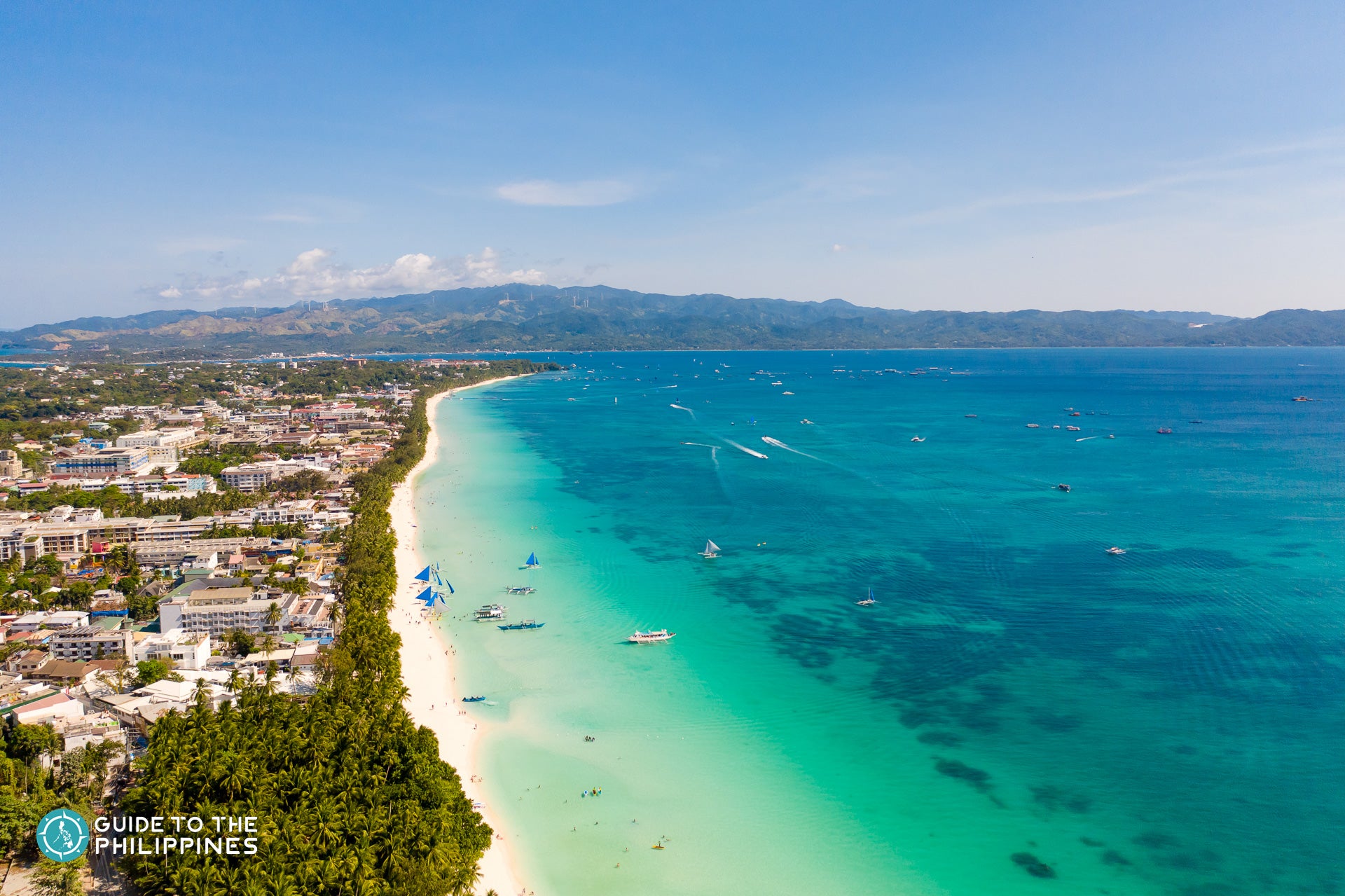The Philippines and its more than 7,000 islands is blessed with some of the best beaches in the world, mountains with panoramic views, historical spots with interesting stories, diving spots with incredible marine life, and more.
Choosing which tourist spots in the Philippines to add to your travel itinerary can be a challenging task. Getting around these spots is another thing that you have to plan carefully.
If you're staying in the capital, Manila, a lot of top attractions in the country are accessible by plane, car, or ferry. Some are less than 5 hours away, making them a perfect addition to multi-day vacation tours from Manila.
If you have limited time to explore the Philippines, read this article to help you choose which attractions to visit from Luzon, Visayas, to Mindanao. Find out how to get there, know what to discover, and how you can make the most of your vacation in the Philippines.
15. Las Casas Filipinas de Acuzar

Just a 4-hour drive or 180 km away from Manila, Las Casas Filipinas de Acuzar is an iconic attraction in Bagac, Bataan, that lets you step back into the Hispanic-American era. With over 22 colonial mansions, this open-air museum showcases 17th-century replicas of Casas or homes from the nearby provinces of Nueva Ecija and Tuguegarao.
As told by owner Jerry Acuzar, these ancestral mansions were carefully reconstructed brick by brick until their grand opening in 2010. Upon entering the 400-hectare resort and museum, visitors will be captivated by its arched bridges, archaic lamp posts, and structures stamped with works of renowned Filipino painters.
Las Casas Filipinas de Acuzar tours also offer a kalesa (horse-drawn carriage) and balsa (boat) ride along its very own Venice-inspired Grand Canal. Among the notable structures here is the 1926 mansion called Casa New Manila. The park also exhibits the Sanctuario de San Jose, Plaza Marcelino, Casa Biñan, Casa Hidalgo, and Hotel De Oriente, the country’s first-ever hotel.
Another sight to behold is Casa Unisan, the first stone house built in Unisan, Quezon. Outside the 1839 mansion is the statue of Lola Basyang, who is known for her timeless folktales. Meanwhile, Casa Luna, a heritage home of Juan and Antonio Luna’s uncle Primitivo, served as a US military headquarters during World War II.
How to Get There:
From EDSA Cubao or Pasay Rotanda in Manila, you may take a bus to Balanga, Bataan. Then, take a Bagac-bound jeepney and alight at the Filipino-Japanese Friendship Tower. Finally, ride a tricycle to Las Casas Filipinas de Acuzar.
If you’re traveling via private vehicle, you can take the Subic Clark Tarlac Expressway (SCTEX) and the Northern Luzon Expressway (NLEX) from Manila.
14. La Union

Surfing in the Philippines is one of the sought-after water activities for beach lovers seeking an adrenaline rush. Deemed as the surfing capital of the North, San Juan municipality in La Union can be accessed just a 5-hour drive or 270 km away from Manila.
Some of the famous surfing spots here are Urbiztondo Beach and Monaliza Point. For starters, you can enroll at various surfing schools in San Juan. Surfers can ride waves that can be as high as 10 feet.
To get the ultimate surfing experience, the best time to go here is during two peak seasons depending on the Habagat and Amihan trade winds, happening from July to October and November to March consecutively.
Meanwhile, other than surfing, San Juan has a lot to offer for surfers and non-surfers alike. There is more to experience beyond riding its beautiful waves, including its hidden wonders and amazing food scene. Don’t forget to try La Union’s Bagnet dishes and handcrafted coffees!
How to Get There:
By public transportation, you may take a direct bus route from Cubao or Pasay in Manila to Sebay Surf Central in Urbiztondo, San Juan, La Union.
By private vehicle, you may take the North Luzon Expressway (NLEx) toward the Subic-Clark-Tarlac Expressway (SCTEx) and the Tarlac-Pampanga-La Union Expressway (TPLEx) until you reach San Juan, La Union.
13. Anilao
 Some of the country’s well-known diving spots are nestled in Anilao, Batangas. Scuba diving in the Philippines began in Mabini town in the 1970s. Back then, the jump-off point was located at Anilao, known as the nudibranch capital of the Philippines. It's the closest diving destination from the metro, being only a 2-hour drive or 125 km away from Manila.
Some of the country’s well-known diving spots are nestled in Anilao, Batangas. Scuba diving in the Philippines began in Mabini town in the 1970s. Back then, the jump-off point was located at Anilao, known as the nudibranch capital of the Philippines. It's the closest diving destination from the metro, being only a 2-hour drive or 125 km away from Manila.
Among the many sights that you can see during diving tours in Anilao, you will find colorful mollusks or nudibranchs beneath its rich coral gardens. These beautiful sea slugs camouflage themselves using the colors they’ve gotten from the sponges and anemones they ate. There are around 800 documented nudibranchs around the world, and 600 of them are found in Anilao.
Anilao is home to several dive sites, including Secret Bay, Anilao Pier, Sombrero Island, Daryl Laut wreck site, and Twin Rocks. Blackwater diving is also a must-try night activity in Anilao for advanced divers. To experience this, a 30-meter long line is tied from a floater at the surface. The lights will serve as your guide to see odd-looking creatures that are hidden during the day.
How to get there:
From Manila, you may ride a bus bound for Batangas. Alight at the Batangas Grand Terminal and take a jeep bound for Mabini (Anilao Port).
If you're traveling via private vehicle, you may take the South Luzon Expressway (SLEx) and Star Tollway. Pass by Batangas Diversion Road then head to Bauan and Mabini, Batangas via Manghinao Bridge.
12. Rizal Park
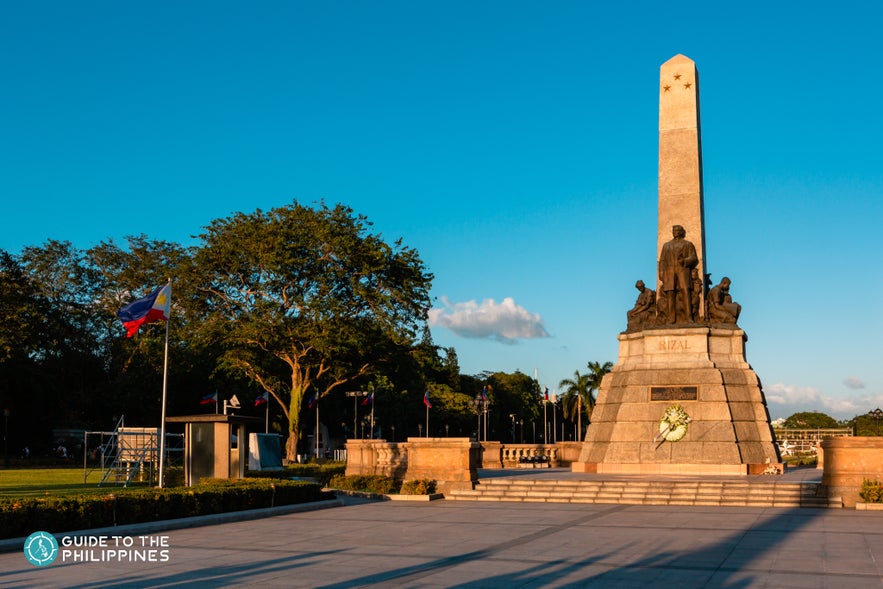
If you want a day tour without going outside Manila, drop by the 60-hectare Rizal Park to have a quick afternoon stroll, ride a bike around the vicinity, or set up a picnic by the green-carpeted grass.
Rizal Park, also known as Luneta, was built to pay homage to the Philippine National Hero, Jose Rizal. It consists of monuments, playgrounds, large stadiums, concert halls, and observatories. Moreover, it is elaborately designed with paved walkways, open lawns, and ornamental gardens. There is also a picnic area right in front of the dancing fountain.
Another must-see attraction near Rizal Park is Chinatown in Binondo, which is only less than 3 km away. It features a plethora of restaurants serving authentic Chinese cuisine, from best-tasting dumplings to other must-try delicacies like fried siopao, oyster cake, mami, and more.
The world’s first-ever Chinatown is also home to Baroque-inspired architecture and Hispanic structures, including Binondo Church and the iconic Escolta Street. You can also find rare pieces of jewelry at Ongpin, where various gold vendors line the street.
How to get there:
The easiest and fastest way to Rizal Park via public transportation is by taking the LRT. Alight at the United Nations Station and walk toward Luneta. You may also ride jeepneys along Taft Avenue that are bound for United Nations or Rizal Park.
If you’re traveling by car, you can just traverse Roxas Boulevard and Taft Avenue.
11. Masungi Georeserve

Another hidden gem near Manila is the Masungi Georeserve, a protected conservation area and eco-tourism site nestled in the rainforests of Rizal. Just a 2-hour ride or 46 km away from Manila, this rustic garden sanctuary features limestones, jade vines, and other rare plant species.
This protected area also serves as a recreational spot for those who want to rejuvenate and re-energize. One of the main tourist attractions of the reserve is the Legacy Trail, which was opened in 2017. It serves as part of the Masungi Geopark Project for reforestation.
The reforestation site features over 47,000 trees, a bamboo-lined uphill called Kawayan, and a series of floating huts and ropeways known as Amihan. Another must-see spot in Masungi Georeserve is the Discovery Trail.
The trekking takes around 3 to 4 hours, and you will pass by rope obstacles and a hanging bridge before you reach Sapot, a web-inspired viewing platform overlooking the Laguna de Bay. Other features of the trail include limestone rock peaks and cave formations.
Apart from majestic nature sites, it also features Silay Dining Room, a hilltop diner for intimate events and gatherings. It is designed with glass, a natural cogon roof, and bamboo highlights.
How to get there:
If by private car, Masungi Georeserve is accessible via Marcos Highway in Baras, Rizal. The entrance is on the right side after the Garden Cottages.
For those commuting from Manila, you can take a jeep from Cubao bound for Cogeo Gate 2. From there, ride a jeep to Sampaloc, Tanay. Alight at Garden Cottages and walk toward the reserve’s entrance.
10. Vayang Rolling Hills, Batanes
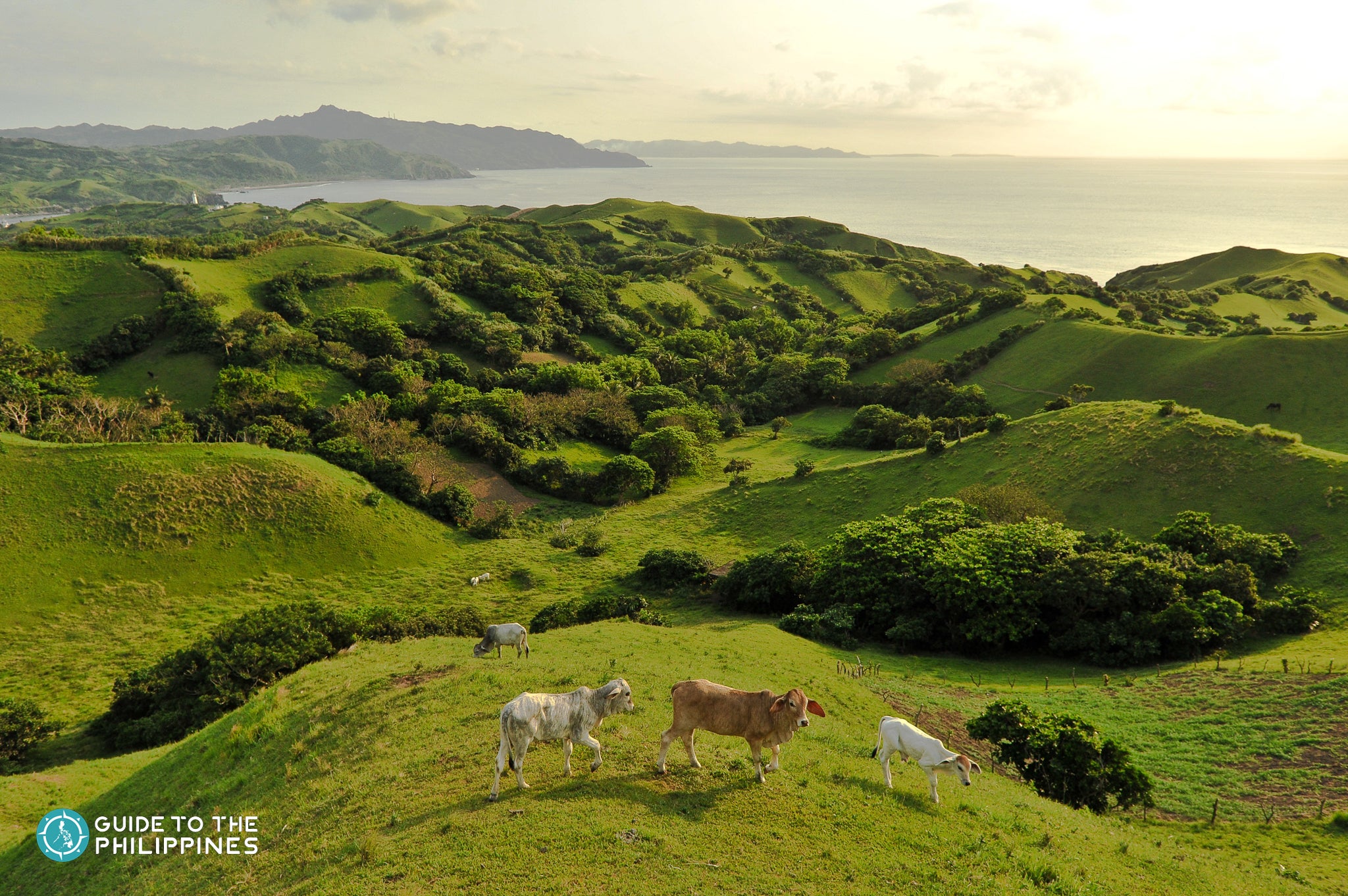
Located north of Luzon in Batanes highlands is the Vayang Rolling Hills, a breathtaking geological formation that features endless waves of soft and carpeted greenery. A huge part of the hills used to be covered with cogon grass that was used by the locals to make their roofs.
The Vayang Rolling Hills, also known as Vayang Ranch, is a sight to behold. The hills offer an unobstructed view of Batan, Sabang, and Itbayat islands facing the West Philippine Sea.
When you’re on top of the hills, you will also see the nearby Chadpidan Beach, the rocky and boulder-filled shoreline on Batan Island.
Vayang Rolling Hills also serves as a grand pasture for carabaos, cows, and goats. The Ivatan farmers take their farm animals to the hillcrest to let them graze or rest. At the farther end of the rolling hills, you can capture the nearby Basco Lighthouse, one of the three major lighthouses in Batanes.
How to get there:
The fastest way to get to Batanes from Manila is by plane. Take a 3-hour flight to Basco from NAIA/Manila Airport or Clark International Airport. Another option is to ride a 20-hour ferry from Sta. Ana, Cagayan and Currimao, Ilocos Sur to Basco.
Book Batanes tours that will take you around the islands of this small province with transfers and guides.
9. Taal Volcano

Nestled in the province of Batangas in Southern Luzon is a picturesque geological formation, the Taal Volcano. Despite being the smallest active volcano in the world, Taal Volcano sits in a large caldera that used to be filled with water from the nearby Taal Lake. However, the main crater lake dried up due to its recent steam explosion in January 2020.
Before the massive eruption happened, local boat operators used to offer a 20-minute boat ride for tourists who wanted to visit the island. Back then, travelers used to ride horses to get to the volcano’s view deck.
- Book a Tagaytay Taal Lake boat ride
Tourists are not allowed to visit Taal Volcano, but you can still capture its beauty if you drop by Tagaytay City attractions and dine at restaurants offering postcard-worthy views along Aguinaldo Highway. Tagaytay is just a 2-hour drive or 65 km away from Manila. It is a go-to spot for those planning a quick weekend getaway near the metro.
How to get there:
From Manila, you can take a bus or van bound for Tagaytay. Once you get there, you can just take a jeep to visit its attractions.
If you’re traveling via private vehicle, you can traverse the South Luzon Expressway (SLEX) and head toward Sta. Rosa/Eton/Greenfields Exit until you reach the Tagaytay National Road.
You can also book Tagaytay tours that will take you to attractions with the best view of Taal Volcano.
8. Intramuros
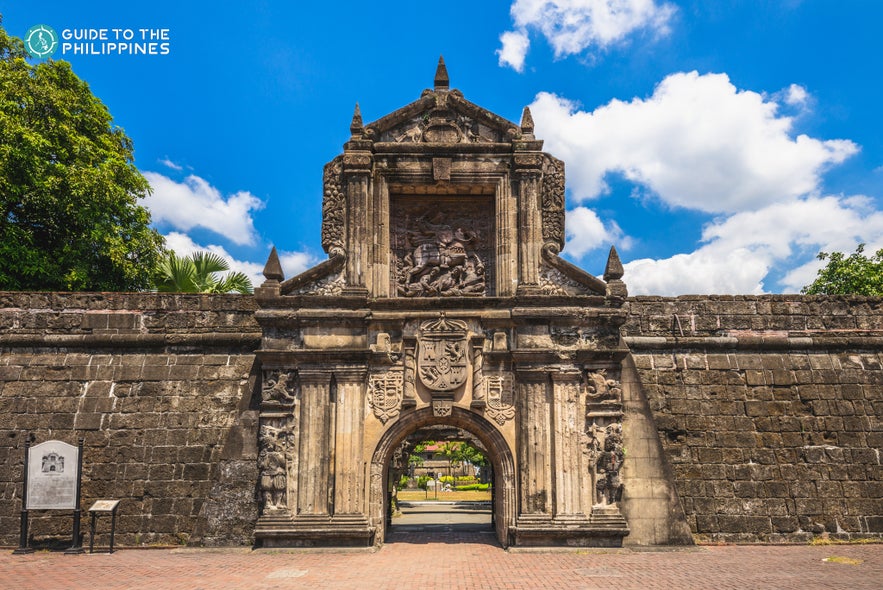
Other than natural attractions, the country also boasts iconic heritage sites. One of the famous historical spots in the Philippines is none other than the walled city of Intramuros. The oldest district of Manila is home to beautifully preserved structures, century-old churches, and museums.
Riding a Bamboo bike and kalesa (horse-drawn carriage) around the historic city will take you to its notable sites, including the old citadel at Fort Santiago. Intramuros has two museums featuring ethnic Chinese and Illustrados, Casa Manila and Bahay Tsinoy. There are also lush landscapes and greeneries at San Diego Gardens, which is right across Baluarte de San Diego.
The walled city is also home to two century-old churches. The first one is the San Agustin Church and Museum, the oldest stone church in the Philippines. Meanwhile, Manila Cathedral is a 300-year-old church with grand facades and multi-layered arches.
How to get there:
From Manila, you can hail a taxicab to Intramuros. Another option is to ride an LRT. Alight at the Central Terminal Station, then walk toward the Manila City Hall. From there, you will pass through a pedestrian underpass that will take you across Padre de Burgos Street and Victoria Street.
For private vehicles, Intramuros is accessible from Roxas Boulevard or Taft Avenue.
You can also join Manila tours that include Intramuros in the itinerary.
7. Cloud 9, Siargao
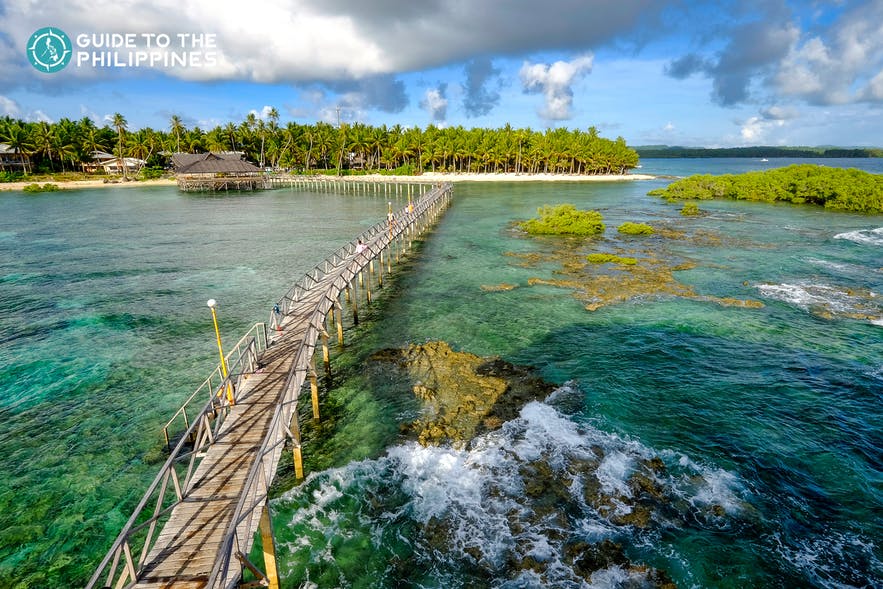
Another go-to surfing destination in the Philippines is Cloud 9 in Siargao, the country’s Surfing Capital. Aside from surfing, travelers also visit Siargao for its beautiful white-sand beaches and naturally-carved tide pools.
Siargao has also maintained its reputation by getting consistent recognition being one of the world’s best surfing spots. The best time to visit Siargao is from September to November, when the waves go higher, reaching heights of 8 feet to 12 feet.
There are numerous surfing spots in Siargao, but Cloud 9 is probably the best one. Local and international surfers who have advanced surfing skills and want to step into the competitive surfing arena often prefer to go to Cloud 9, which is ranked among the world’s top ten waves.
Those who are just beginning to learn how to surf can go to beginner-friendly surf spots near Cloud 9, like the Jacking Horse. There are also surf camps offering surfing lessons that range from 1 to 8 days. Aside from surfing, Siargao is also known for its luxury accommodations and restaurants. Some of the best spots for foodies include Kermit Siargao and Shaka Cafe.
How to get there:
The most convenient way to get to Siargao from Manila is by direct flight. From Manila, the travel time takes less than 3 hours to get there. Upon arrival, you can hail a tuk-tuk or tricycle to General Luna, where Cloud 9 is located.
6. Big Lagoon, El Nido
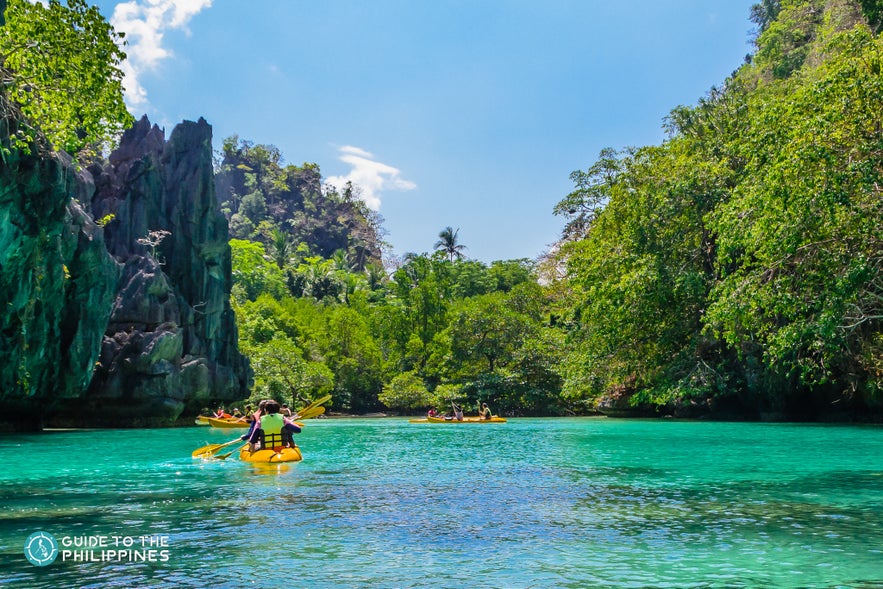
El Nido’s beautiful town in Palawan has been constantly recognized as one of the world’s best islands. This famous attraction in the Philippines never fails to draw and amaze travelers with its gorgeous and exotic beauty. Beneath its crystal clear turquoise waters lie stunning limestone formations, powdery white-sand shores, and pristine islands.
One of the must-see tourist spots in El Nido is the Big Lagoon. It is situated on Miniloc Island, a gateway to the popular resorts and attractions along Bacuit Bay. To get inside this lagoon, you will board a kayak and paddle your way through the shallow entrance leading to a huge natural pool with towering limestone cliffs.
Small Lagoon is also a nearby attraction on Miniloc Island next to the Big Lagoon. It has a smaller entrance where you can swim or ride a kayak through a limestone crack. Similarly, it has an enchanting vibe and breathtaking views.
How to get there:
The easiest and fastest way to go to El Nido is to take a direct flight through AirSwift from Manila to Palawan via Lio Airport. The travel time only takes one hour and 30 minutes. Another option is to fly to Puerto Princesa and ride a van to El Nido, which approximately takes around 5 to 6 hours. You can book El Nido island-hopping tours that include Big Lagoon in the itinerary.
5. Chocolate Hills, Bohol
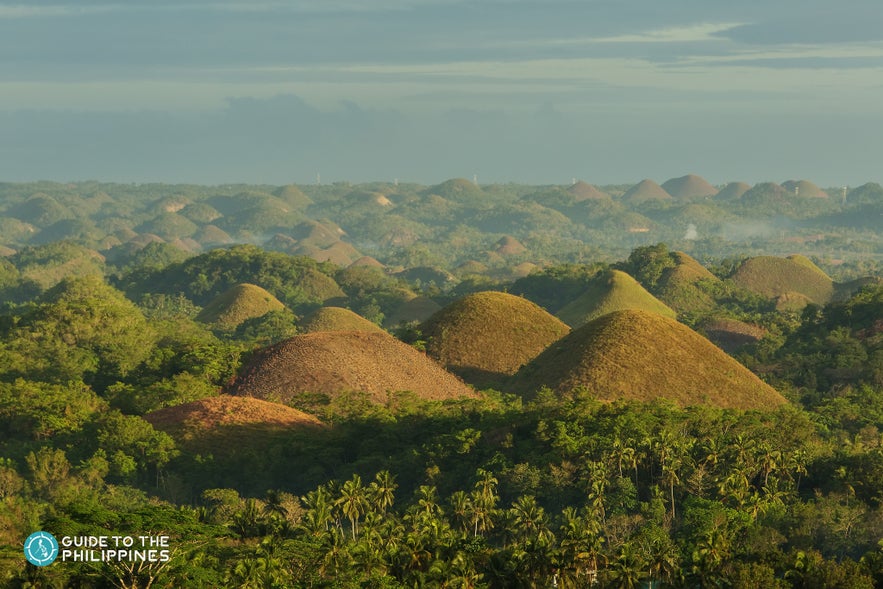
The famed Chocolate Hills in Bohol is a stunning geological formation consisting of more than 1,000 cone-shaped hills with color-changing vegetation depending on the season. This breathtaking attraction stretches over 50 square kilometers of land across to the towns of Carmen, Batuan, and Sagbayan.
It is recognized as the country’s third National Geological Monument and one of the Eight Wonders of the World. The ideal time to go to the Chocolate Hills is during the dry months, from December until May. During the peak season, the grass-covered land turns into chocolatey brown. It changes to vibrant green during the rainy season.
Apart from its scenic landscape, you can also try adventure activities at its newest eco-tourism hub called the Chocolate Hills Adventure Park. Some of the must-try activities include hiking, mountain biking, and horseback riding.
Adventure-seekers can also try various outdoor activities, including Rush Bike Zipline, Wave Runner Surf Zipline, and Spiderman Wall Climbing. The park also offers Tree Top Rope Challenge courses for children and adults.
How to get there:
The best way to go to Bohol is by flying from Manila to Bohol-Panglao International Airport. Philippine Airlines, Cebu Pacific, and AirAsia have daily flights from Manila to Bohol. The travel time takes around an hour and a half.
Upon arrival, you can hire a private van or just ride a bus from Dao Integrated Bus and Jeepney Terminal bound for Carmen town, where the Chocolate Hills are located.
You can also book Bohol Countryside tours which include a visit to the Chocolate Hills.
4. Kawasan Falls, Cebu
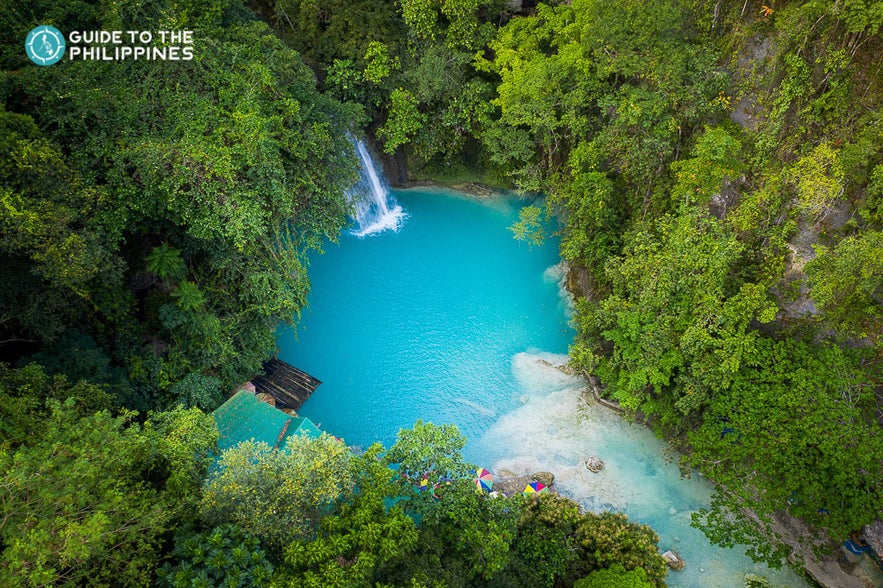
If you’re on for extreme heart-pounding adventures, go canyoneering at the enchanting three-tiered Kawasan Falls in Badian, Cebu. Exploring Kawasan Falls downstream will lead you to a 5 km stretch of sharp rock edges and changing terrains. You will also pass by the beautiful gorges of the Badian River until you reach its natural pools and crystal-clear waters.
The breathtaking cascade has three levels. The first level is the most crowded spot. Meanwhile, the second level is where you get to jump off a 50-foot cliff straight to a spacious and deep plunge pool. The third level, on the other hand, features natural pools with crystal emerald-blue waters.
The water cascading toward the falls comes from Kabukalan Spring. Kawasan Falls is also deemed one of the cleanest inland bodies of water in the Philippines. After your canyoneering adventure, you can rent a raft toward the cascading falls for a hydro-massage or simply sit down and enjoy the lush scenery.
How to get there:
You can take a direct flight from Manila to Cebu via Mactan-Cebu International Airport. Upon arrival, you can take a taxi to South Bus Terminal. Then, ride a bus bound for Badian town, where you can find the Kawasan Falls. The travel time takes approximately 3 hours.
You can also book Kawasan Falls tours with transfers.
3. Kayangan Lake, Coron

While Palawan boasts the finest lagoons and islands in the world, it is also home to breathtaking lakes. One of which is found in Coron town, Kayangan Lake. It is surrounded by tall limestone formations and lush greenery.
With its jade-green waters, Kayangan Lake is undeniably the cleanest lake in the Philippines and one of the cleanest in Asia. The water is so clear that you can already see through beneath the surface. Kayangan Lake is one of the two out of eight lakes that are open for tourists in Coron, Palawan. It is 70% freshwater and 30% salt water with a depth of approximately 20 feet.
Before it became one of the top tourist attractions in Coron, the lake was believed to be an ancestral domain for the Tagbanuas, an indigenous tribe in Coron. To get to this pristine spot, you have to go on an uphill climb toward the inland lake. There is also a view deck where you can capture its picturesque scenery.
How to get there:
The most convenient way to get to Coron, Palawan is by taking a direct flight from Manila to Busuanga. Philippine Airlines, Cebu Pacific, and Skyjet offer daily flights from Manila to Coron. The travel time takes around an hour and 30 minutes.
You can book Coron island-hopping tours that include a visit to Kayangan Lake.
2. Puerto Princesa Underground River, Palawan

One of the best attractions in Puerto Princesa is the world-famous Puerto Princesa Underground River, which has been recognized as a UNESCO World Heritage Site since 1999. It is also declared as one of the New 7 Wonders of Nature.
The subterranean river stretches over 8.2 km with water that directly goes into the sea. Inside the cave, you will witness stunning cave formations, stalactites, and stalagmites taking the form of a man’s head, a ship, and other unique shapes.
The best time to go to Puerto Princesa Underground River is during the dry season, from November to May. The summer months take place from March to May, while the rainy season begins from June to October.
How to get there:
The most hassle-free way to get to Puerto Princesa is by taking an hour and 30-minute direct flight from Manila to Puerto Princesa International Airport. From there, you can rent a van bound for Sabang Port. Then, you’ll ride a small boat from Sabang Wharf to Sabang Beach, which is the entry point to the cave.
For a hassle-free trip, it's best to book a Puerto Princesa Underground River tour that includes transfers.
1. White Beach, Boracay
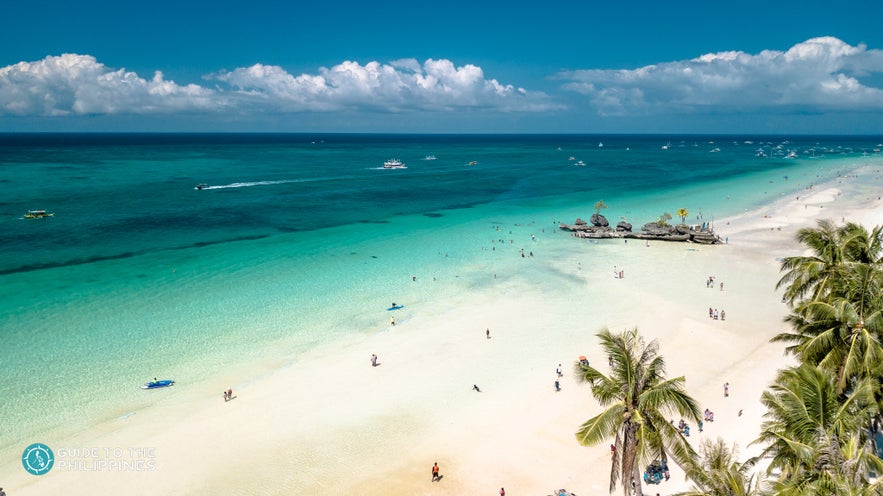
One of the most famous white-sand beaches in the Philippines and in the world is nestled on Boracay Island, known as White Beach. This world-renowned beach is situated in the province of Aklan in the Western Visayas region.
Thousands of local and international travelers go to Boracay each year to experience setting foot on its long stretch of powdery white sand and its clear blue waters. In 2018, Boracay closed its doors to pave the way for its rehabilitation. Boracay has become stunning and captivating now more than ever.
Along the White Beach area, you can find Boracay resorts and hotels lining its three stations: Station 1, 2, and 3. There are also restaurants and souvenir shops that are mostly laid out on Station 2.
Make the most of your stay by trying out exciting Boracay tours that include water activities like kite surfing, paddle boarding, banana boating, parasailing, and helmet diving. Lastly, don’t miss out on the chance to gaze at Boracay’s magical sunset.
How to get there:
The most convenient way to get to Boracay is by taking a direct flight from Manila to Caticlan Airport. From there, you can ride a bus or tricycle bound for Jetty Port. Then, you will ride a boat to Boracay Island. The travel time from Manila to Boracay takes around an hour and 30 minutes.
You can also book Boracay package deals that often include accommodations and airfare from Manila for a hassle-free trip.
Discover the Top Tourist Spots in the Philippines
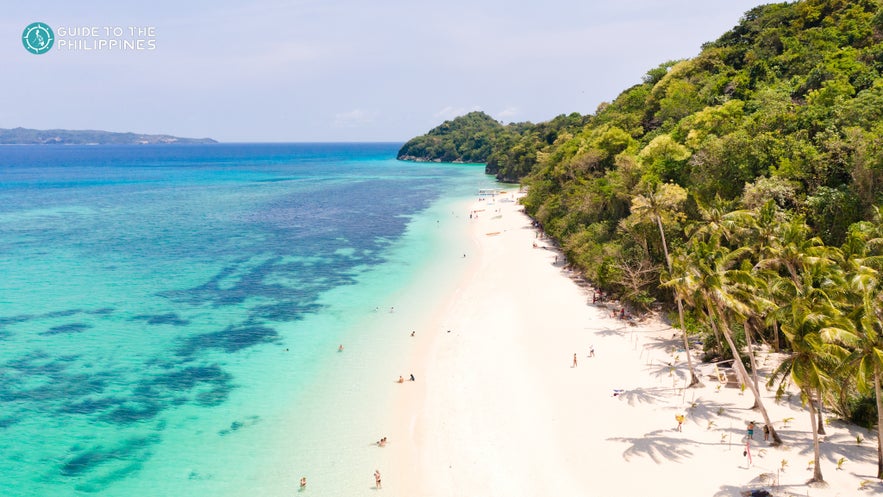
Filled with majestic beaches and notable heritage sites, the Philippines is a tropical country with only two seasons per year, the dry and wet season, thus making it a perfect destination for travelers all year round.
The Philippines’ tourist spots have become more accessible since local airlines offer daily flights from Manila to almost anywhere in the country. There are also tourist attractions and beach resorts near Manila that can be easily reached either via private vehicle or public transport.
However, a day won’t still be enough to explore all of the country’s countless beaches, lagoons, falls, geological formations, and historical structures. To make the most of your vacation, you may opt to book the best Philippines tour packages.
It's time to start planning your dream getaway and visit some of the best tourist spots that are accessible from Manila. Find out the best Philippines tours featuring the top beaches, mountains, and historical spots in the country. Check our Philippines vacation packages that include accommodations and transfers from Manila for a hassle-free getaway.




